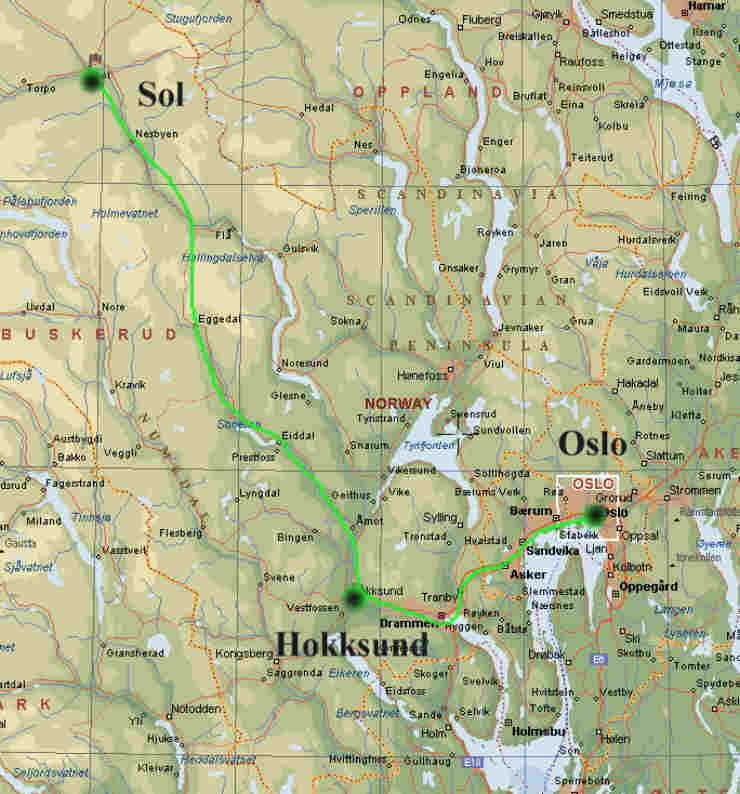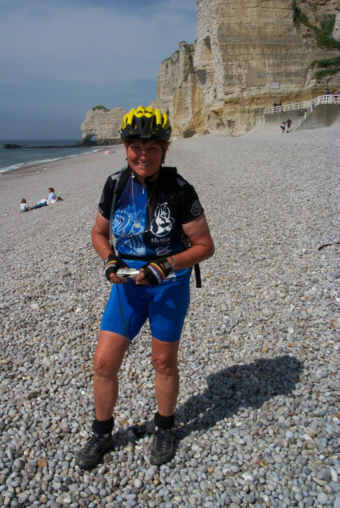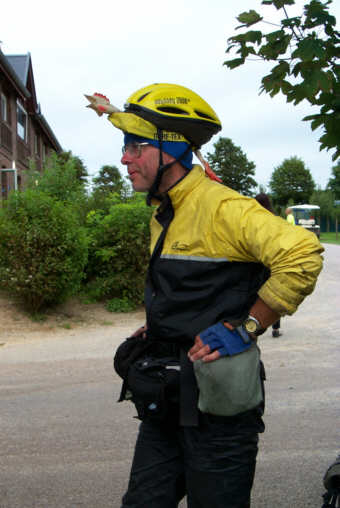

Page 58
Norway 

DAY
199
Gol
to Hokksund
I
awoke to the patter of rain on my tent so I did what any sensible person would,
I shut off the alarm and went back to sleep. Luckily I didnít snooze for long,
but I had to really hustle to make up the lost time. The good news was that by
the time weíd had breakfast the rain had stopped and we could take off the
rain clothes. Joan and I cycled together again, it was her first day back on a
bike in two weeks or so.
We
cycled through, and up and down, 145 km. of rural Norway and every inch of it
was beautiful. It is very green, litter free, and as neat as a pin. But what
really amazed me is the condition of the buildings. We passed countless
farms, each with a huge barn and other outbuildings plus the house of course,
and every building looked like it had been painted just yesterday. The barns and
other farm buildings are all red, and all the very same red. Most of the houses
are white. I am wondering whether there is a government subsidy for paint? If
so, what a great idea. I wish there was a way to get the barns of America
painted. Grain is being raised on all these farms, a few had some cattle, but
most of the acreage was grain. There were a few fields of potatoes, but I didnít
see corn which surprised me because Norwegians use a lot of corn and put it in
unexpected places like tuna sandwiches. Hay is hung to dry on long fences that
are in the hayfields just for that purpose. Eventually it is formed into huge
circular bales and wrapped in white plastic, to be stored for use in the winter.
After
a 14 km. steep climb early in the day we reached a forested area where sheep
grazed unfenced. By the time I got there they had finished grazing and were
lying on the road chewing their cuds. It was pretty cute. They were undisturbed
by the traffic weaving among them, including bikes, and just ignored us
altogether.
As
the day wore on and Joan got more tired, she campaigned more forcefully for
taking a short cut. You would not believe the hills we had had to climb! No
wonder she wanted out. Finally she wore me down and I agreed to a shortcut, or
at least what we hoped would be a hill cut. It worked! When we got back on the
route we found that we were ahead of people we had been behind. As it got later
and she became more tired and sore, she insisted on another shortcut. I could
sympathize with how she was feeling, having spent a couple of weeks out of the
saddle recently myself, so I agreed to go with her. As it turned out, our route
may have been a bit shorter but I am sure it wasnít less hilly. We were sure
glad to make camp. It was nearly 6:30 and our tents were soaking wet from the
rain the night before. We hurried to get them up as soon as possible, so that
they could dry before bedtime.
We
are camping at Hokksund Bat and Camping, a four star campground on a wide river.
We were welcomed by the mayor who made a short speech at dinner, then
entertained by a loud brass band while we ate.
It
is lovely to be back in my tent again and have this space all to myself. But
tomorrow we go to Oslo and Iíll have to share a room with 3 others. That is
not ďbetterín a tentĒ!
Goodbye, Alice
DAY 200
Hokksund
to Oslo
We had a short uneventful ride today, only 65 km. to our last destination in Norway, Oslo. When it started to rain we took that as a good excuse to stop for coffee and a yummy pastry. Tim of TK&A had really done his homework and designed a route that was almost entirely off the busy highway. Norway has provided well for cyclists. We rode on bike paths most of the way and right into the heart of Oslo. I have found the motorists here to be the most cyclist friendly yet. They even stop on the highways for cyclists waiting to cross at a crosswalk. I would have thought that the highway traffic had the right of way, but a cyclist is like a red light to these drivers.
The Norwegian people have been friendly and curious about our trip. Fortunately for us most everyone can speak English making it easy for us to communicate. One woman who had seen us on television stopped to greet us and then apologized for the weather. It should be sunnier she said. We have been happy enough with the weather because it has been better than it usually is for us. It rained on our ride today but not so hard that we couldnít see where we were going and an hour or so later we rode in sunshine.
We are staying at the Anker Hotel for two nights. Our room is big with a big window so that we have lots of light. There is a cone-shaped church steeple in my view, a very slender and tall cone with a large and proud rooster weather vane at the top. Iím wondering how that rooster was placed there. Maybe angels did it. I have different roommates for a change, Sandy and Roma. They have spent more time off-route, away from Odyssey, than they have spent doing the daily grind with us. It is a nice surprise to see them again. Maybe they have decided that Scandinavia is too expensive to do on their own.
If there were a downside to visiting Norway it would be the cost. It is way expensive, perhaps double or even more, than the United Kingdom, Southern Europe and the States. Budget travelers need to be very resourceful here. We are appreciative of the two square meals a day that TK&A has arranged. But we have to eat on the road too and that adds up. I wish I could remember some prices but not many come to mind. Yesterday I treated myself to a delicious dessert and coffee. It was 50 kroner or about $6, which was reasonable for that lovely crepe filled with blueberry sauce and ice cream. But bananas are about $.60 each, a Coke is about $3, a beer about $6, and the smallest hamburger about $5. The apartments or self-catering units that we rented for 3 nights on our escapade, ran about $30 each per night which we thought affordable for a splurge, but it was at least twice as much as a B&B in Scotland for example. At the last hotel they charged us each $10 extra for linens which we found outrageous. At the Montana Hostel where we first stayed in Bergen, a bed in a dormitory would have been 140 kroner or about $17. That is reasonable but you share the room with 23 other people. I donít know what the rooms run in the Anker Hotel in Oslo where we are staying but I did see a poster advertising breakfast and lunch here for 50 and 120 kroner, or about $5 for breakfast and $13 for lunch which is very reasonable compared to other prices. A lunch buffet I saw at Flam was 350 kroner or $43. Wow!
Two injured riders that we left behind in Bergan, Shirl and Suzi, have both rejoined us here in Oslo. Suziís pain from the slipped disk comes and goes but she was walking normally and without pain last evening so that is progress. Shirlís no longer in pain either and is happy with her decision to forego surgery to repair her ruptured bicep. She is ready to ride!
One reader wrote asking about the costs involved in renting a car. There are about a dozen groups of people who have rented cars, the number of people who share the car and the cost varies from one to six I believe. The advantages of more people are lower costs and more drivers so that more days are free to cycle, and the disadvantages include more planning and compromises about going off-route. One problem for all the car groups has been getting the car from one country to another when a ferry crossing is necessary. The major ferry crossings have required booking far in advance and may make crossings only twice a week. Those who are unaware of that find themselves in a predicament. At least one group has solved that problem by leaving the car behind for major ferry crossings and renting another one in the next country. Most groups though have leased the cars for all of Europe as the per day rate is less. One couple bought a car and another couple bought a camper van.
I asked a group of four who have leased a car about the costs. Each share of the lease is about $200 a month. A tank of gasoline is $50 to $60, shared four ways. If a tank a week were required, that would bring the cost for each person to about $250 a month. It is actually more than that though because of tolls for roads, bridges and ferries. Some people have become disenchanted with the car idea for several reasons, one being that it is just so easy and comfortable to ride in the car that they seldom get on their bicycles. Those people have a second problem and that is how to get out of a group without losing the money paid upfront and without causing a financial hardship for the ones remaining in the group.
One reader wrote asking whether we have stayed within our budgets that we set for ourselves before the trip began. In a word, no. Everyone I asked admits to going over budget, some having spent the entire yearís budget already. I am not surprised at this because I have traveled and itís been my experience that I always spend about double what I think I will. On this trip Iím not keeping a record of my spending, just trying to be reasonable. What is causing me the greatest expense, that I had not anticipated because I just didnít realize it would be a big deal, is the web page. The phone bills, largely for sending e-mail, have been very high each month that I have used AT&T. I avoid that now when I can by buying and using the phone cards in each country. Norway, which seems a more expensive place for most things, has a reasonable long distance rate. Mailing has also been expensive. We often have too little lead-time to receive things sent by normal airmail, so end up spending large amounts for guaranteed delivery. Two digital photo cards and now perhaps a third have been lost in the mail. Those cost the earth and to buy replacements makes them cost twice as much it seems to me. And so it goes!
Tomorrow
is a sightseeing day in Oslo so Iíll be out there spending more money!
Goodbye,
Alice
DAY
201
Oslo
Layover Day
I
spent the entire day sightseeing, by myself, which was a nice treat. First thing
in the morning I rode the bus to the island of Bygdoy to tour the museums there.
I started with the Norwegian Folk Museum, a collection of restored homes and
farm buildings dating back to the Middle Ages. There was much to see and
fortunately there was a guided tour from which I learned and saw more than I
could have on my own. There were foods to sample and craftsmen at work. There
were pigs and sheep and horses. The guide described the construction of the sod
roofs on the houses which have been of interest to me because they seem to be
unique to Norway, or at least I havenít seen them elsewhere. First there are
layers of birch bark, then two layers of sod, the first layer grass side down
and the second layer grass side up. That way the grass roots of the top layer
had somewhere to go she explained. She took us to houses constructed over a
period of several hundred years so that we could see the development that
occurred. The earliest houses were built of enormous logs notched together at
the corners. They could be taken apart and moved if necessary. They had an open
fire in the center of the single room with a smoke hole in the roof above it.
There were no windows and the house would have filled with smoke so it would
have been a dingy, unhealthy place to live. Eventually the fire was moved
to a raised area in the corner of the room, a chimney was added, and finally
windows. With the chimney there was less smoke in the house so the walls and
furnishings did not get sooty and dirty. It was then that the people began to
add color and decorate their homes. A major attraction at the Folk Museum is the
Gol Stave Church dating from about 1200. The stave churches were built entirely
of wood and while there were once thousands, there are now perhaps only 2 dozen
left.
Next
I visited the Viking Ship Museum where three Viking ships and many articles used
by the Vikings are displayed. Very wealthy Vikings and Viking royalty were
buried in ships along with everything they would need in the afterlife including
a servant, wagons and the horses to pull them, and plenty of food. One such ship
was found by a farmer in his field while he was digging for gold. It was a queenís
burial ship and had been perfectly preserved for more than 1000 years because of
the type of soil in which it was buried. That ship was excavated in 1904, and
after 20 years of work by archaeologists to conserve it and reconstruct it, it
was put on exhibit. It is known as the Oseberg ship after the place where it was
found. The other two ships on display at the museum were also burial ships but
were not so perfectly preserved.
Then
I went to the Kon-Tiki Museum where the Ra II, Thor Heyerdahlís papyrus boat
in which he successfully sailed across the Atlantic in 1970 is displayed, along
with other vessels and objects from his many expeditions. Now there was a man
who just didnít know when to quit! Someday I would like to read at least a
couple of his books. I did get to see a 9 minute film of actual footage shot
during both his failed attempt with Ra I which fell apart, and his
successful attempt with Ra II to cross the Atlantic. What courage he and his
international crews had!
I
ended my day with a ferry ride from Bygdoy where the museums are to Radhusbrygge,
on Osloís waterfront. There are sailing ships, big cruise ships, Viking ships,
and dinner cruise vessels. There are colorful flags, ice cream shops and hot dog
shops, people and dogs and bicycles and electric trams. It is a happening place!
Now
dinner is happening so I am out of here!
Goodbye, Alice
Norway
![]()


Wales
![]()


Barmouth, Wales

Odyssey Riders and Staff


Note the Chicken under the bike helmet on the right picture - the award for the last arrival of the day.
Today's Music
Elverdans (Elf's dance)